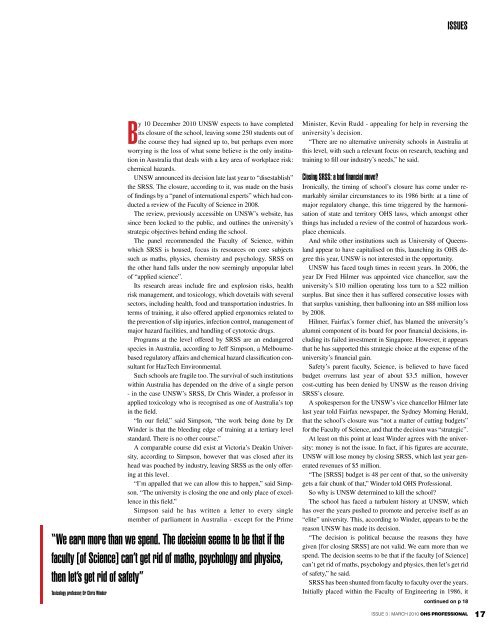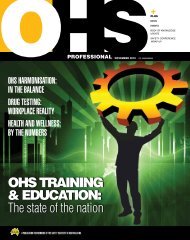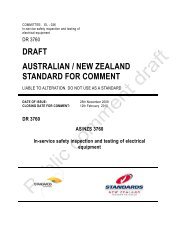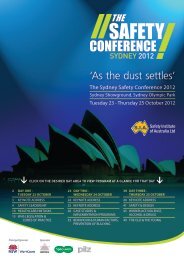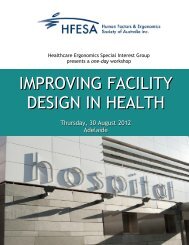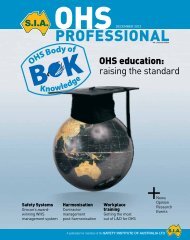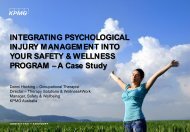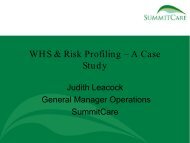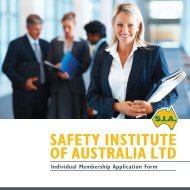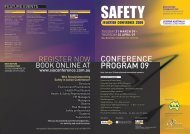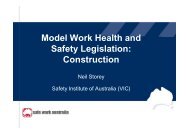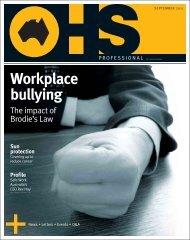Defence: overcoming its âcan Doâ culture unsW kills safety anD risk ...
Defence: overcoming its âcan Doâ culture unsW kills safety anD risk ...
Defence: overcoming its âcan Doâ culture unsW kills safety anD risk ...
Create successful ePaper yourself
Turn your PDF publications into a flip-book with our unique Google optimized e-Paper software.
issuesby 10 December 2010 UNSW expects to have completed<strong>its</strong> closure of the school, leaving some 250 students out ofthe course they had signed up to, but perhaps even moreworrying is the loss of what some believe is the only institutionin Australia that deals with a key area of workplace <strong>risk</strong>:chemical hazards.UNSW announced <strong>its</strong> decision late last year to “disestablish”the SRSS. The closure, according to it, was made on the basisof findings by a “panel of international experts” which had conducteda review of the Faculty of Science in 2008.The review, previously accessible on UNSW’s website, hassince been locked to the public, and outlines the university’sstrategic objectives behind ending the school.The panel recommended the Faculty of Science, withinwhich SRSS is housed, focus <strong>its</strong> resources on core subjectssuch as maths, physics, chemistry and psychology. SRSS onthe other hand falls under the now seemingly unpopular labelof “applied science”.Its research areas include fire and explosion <strong>risk</strong>s, health<strong>risk</strong> management, and toxicology, which dovetails with severalsectors, including health, food and transportation industries. Interms of training, it also offered applied ergonomics related tothe prevention of slip injuries, infection control, management ofmajor hazard facilities, and handling of cytotoxic drugs.Programs at the level offered by SRSS are an endangeredspecies in Australia, according to Jeff Simpson, a Melbournebasedregulatory affairs and chemical hazard classification consultantfor HazTech Environmental.Such schools are fragile too. The survival of such institutionswithin Australia has depended on the drive of a single person- in the case UNSW’s SRSS, Dr Chris Winder, a professor inapplied toxicology who is recognised as one of Australia’s topin the field.“In our field,” said Simpson, “the work being done by DrWinder is that the bleeding edge of training at a tertiary levelstandard. There is no other course.”A comparable course did exist at Victoria’s Deakin University,according to Simpson, however that was closed after <strong>its</strong>head was poached by industry, leaving SRSS as the only offeringat this level.“I’m appalled that we can allow this to happen,” said Simpson.“The university is closing the one and only place of excellencein this field.”Simpson said he has written a letter to every singlemember of parliament in Australia - except for the Prime“We earn more than we spend. the decision seems to be that if thefaculty [of science] can’t get rid of maths, psychology and physics,then let’s get rid of <strong>safety</strong>”toxicology professor, Dr chris WinderMinister, Kevin Rudd - appealing for help in reversing theuniversity’s decision.“There are no alternative university schools in Australia atthis level, with such a relevant focus on research, teaching andtraining to fill our industry’s needs,” he said.closing srss: a bad financial move?Ironically, the timing of school’s closure has come under remarkablysimilar circumstances to <strong>its</strong> 1986 birth: at a time ofmajor regulatory change, this time triggered by the harmonisationof state and territory OHS laws, which amongst otherthings has included a review of the control of hazardous workplacechemicals.And while other institutions such as University of Queenslandappear to have capitalised on this, launching <strong>its</strong> OHS degreethis year, UNSW is not interested in the opportunity.UNSW has faced tough times in recent years. In 2006, theyear Dr Fred Hilmer was appointed vice chancellor, saw theuniversity’s $10 million operating loss turn to a $22 millionsurplus. But since then it has suffered consecutive losses withthat surplus vanishing, then ballooning into an $88 million lossby 2008.Hilmer, Fairfax’s former chief, has blamed the university’salumni component of <strong>its</strong> board for poor financial decisions, including<strong>its</strong> failed investment in Singapore. However, it appearsthat he has supported this strategic choice at the expense of theuniversity’s financial gain.Safety’s parent faculty, Science, is believed to have facedbudget overruns last year of about $3.5 million, howevercost-cutting has been denied by UNSW as the reason drivingSRSS’s closure.A spokesperson for the UNSW’s vice chancellor Hilmer latelast year told Fairfax newspaper, the Sydney Morning Herald,that the school’s closure was “not a matter of cutting budgets”for the Faculty of Science, and that the decision was “strategic”.At least on this point at least Winder agrees with the university:money is not the issue. In fact, if his figures are accurate,UNSW will lose money by closing SRSS, which last year generatedrevenues of $5 million.“The [SRSS] budget is 48 per cent of that, so the universitygets a fair chunk of that,” Winder told OHS Professional.So why is UNSW determined to kill the school?The school has faced a turbulent history at UNSW, whichhas over the years pushed to promote and perceive <strong>its</strong>elf as an“elite” university. This, according to Winder, appears to be thereason UNSW has made <strong>its</strong> decision.“The decision is political because the reasons they havegiven [for closing SRSS] are not valid. We earn more than wespend. The decision seems to be that if the faculty [of Science]can’t get rid of maths, psychology and physics, then let’s get ridof <strong>safety</strong>,” he said.SRSS has been shunted from faculty to faculty over the years.Initially placed within the Faculty of Engineering in 1986, itcontinued on p 18ISSUE 3 | MARCH 2010 OHS PrOfeSSiOnaL 17


